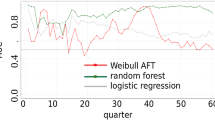Abstract
In this article, we describe the construction and implementation of a pricing model for a leading UK mortgage lender. The crisis in mortgage lending has highlighted the importance of incorporating default risk into such pricing decisions by mortgage lenders. In this case the underlying default model is based on survival analysis, which allows the estimation of month-to-month default probabilities at a customer level. The Cox proportional hazards estimation approach adopted is able to incorporate both endogenous variables (customer-specific attributes) and time-covariates relating to the macro-economy. This allows the lender to construct a hypothetical mortgage portfolio, specify one or more economic scenarios, and forecast discounted monthly cash flow for the lifetime of the loans. Monte Carlo simulation is used to compute different realisations of default and attrition rates for the portfolio over a future time horizon and thereby estimate a distribution of likely profit. This differs from a traditional scorecard approach in that it is possible to forecast default rates continually over a time period rather than within a fixed horizon, which allows the simulation of cash flow, and differs from the company's existing pricing model in incorporating the possibilities of both default and early closure.







Similar content being viewed by others
References
Allison, P.D. (1995) Survival Analysis Using the SAS System: A Practical Guide. Cary, NC: SAS Institute.
Andersen, P.K., Borgan, O., Gill, R.D. and Keiding, N. (1993) Statistical Models Based on Counting Processes. New York: Springer-Verlag.
Cox, D.R. (1972) Regression models and life-tables (with discussion). Journal of Royal Statistical Society, Series B 74: 187–220.
Ross, S.M. (2006) Simulation. Burlington, MA: Elsevier Academic Press.
Stepanova, M. and Thomas, L.C. (2001) PHAB scores: Proportional hazards analysis behavioural scores. Journal of Operational Research Society 52: 1007–1016.
Stepanova, M. and Thomas, L.C. (2002) Survival analysis methods for personal loan data. Operations Research 50: 277–289.
Tang, L., Thomas, L.C., Thomas, S. and Bozzetto, J.-F. (2007) It's the economy stupid: Modelling financial product purchases. International Journal of Bank Marketing 25 (1): 22–38.
Therneau, T.M. and Grambsch, P.M. (2000) Modeling Survival Data: Extending the Cox Model. Springer: New York.
Thomas, L.C., Banasik, J. and Crook, J.N. (1999) Not if but when will borrowers default. Journal of Operational Research Society 50: 1185–1190.
Thomas, L.C., Crook, J.N. and Edelman, D.B. (2002) Credit Scoring and its Applications. Philadelphia, PA: SIAM.
Author information
Authors and Affiliations
Corresponding author
Rights and permissions
About this article
Cite this article
McDonald, R., Matuszyk, A. & Thomas, L. Application of survival analysis to cash flow modelling for mortgage products. OR Insight 23, 1–14 (2010). https://doi.org/10.1057/ori.2009.15
Published:
Issue Date:
DOI: https://doi.org/10.1057/ori.2009.15




